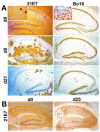Transgenic mice expressing the nucleoprotein of Borna disease virus in either neurons or astrocytes: decreased susceptibility to homotypic infection and disease
- PMID: 15016883
- PMCID: PMC371057
- DOI: 10.1128/jvi.78.7.3621-3632.2004
Transgenic mice expressing the nucleoprotein of Borna disease virus in either neurons or astrocytes: decreased susceptibility to homotypic infection and disease
Abstract
The nucleoprotein (N) of Borna disease virus (BDV) is the major target of the disease-inducing antiviral CD8 T-cell response in the central nervous system of mice. We established two transgenic mouse lines which express BDV-N in either neurons (Neuro-N) or astrocytes (Astro-N). Despite strong transgene expression, neurological disease or gross behavioral abnormalities were not observed in these animals. When Neuro-N mice were infected as adults, replication of BDV was severely impaired and was restricted to brain areas with a low density of transgene-expressing cells. Notably, the virus failed to replicate in the transgene-expressing granular and pyramidal neurons of the hippocampus (which are usually the preferred host cells of BDV). When Neuro-N mice were infected within the first 5 days of life, replication of BDV was not suppressed in most neurons, presumably because the onset of transgene expression in the brain occurred after these cells became infected with BDV. Astro-N mice remained susceptible to BDV infection, but they were resistant to BDV-induced neurological disorder. Unlike their nontransgenic littermates, Neuro-N mice with persistent BDV infection did not develop neurological disease after immunization with a vaccinia virus vector expressing BDV-N. In contrast to the situation in wild-type mice, this treatment also failed to induce N-specific CD8 T cells in the spleens of both transgenic mouse lines. Thus, while resistance to BDV infection in N-expressing neurons appeared to result from untimely expression of a viral nucleocapsid component, the resistance to BDV-induced neuropathology probably resulted from immunological tolerance.
Figures








Similar articles
-
CD8 T cells require gamma interferon to clear borna disease virus from the brain and prevent immune system-mediated neuronal damage.J Virol. 2005 Nov;79(21):13509-18. doi: 10.1128/JVI.79.21.13509-13518.2005. J Virol. 2005. PMID: 16227271 Free PMC article.
-
Vaccine-induced protection against Borna disease in wild-type and perforin-deficient mice.J Gen Virol. 2005 Feb;86(Pt 2):399-403. doi: 10.1099/vir.0.80566-0. J Gen Virol. 2005. PMID: 15659759
-
T cell ignorance in mice to Borna disease virus can be overcome by peripheral expression of the viral nucleoprotein.Proc Natl Acad Sci U S A. 1999 Aug 17;96(17):9769-74. doi: 10.1073/pnas.96.17.9769. Proc Natl Acad Sci U S A. 1999. PMID: 10449769 Free PMC article.
-
Molecular and cellular biology of Borna disease virus infection.Microbes Infect. 2002 Apr;4(4):491-500. doi: 10.1016/s1286-4579(02)01564-2. Microbes Infect. 2002. PMID: 11932200 Review.
-
[Neuropathogenesis of persistent infection with Borna disease virus].Uirusu. 2015;65(1):145-54. doi: 10.2222/jsv.65.145. Uirusu. 2015. PMID: 26923969 Review. Japanese.
Cited by
-
Animal models of CNS viral disease: examples from borna disease virus models.Interdiscip Perspect Infect Dis. 2010;2010:709791. doi: 10.1155/2010/709791. Epub 2010 Feb 24. Interdiscip Perspect Infect Dis. 2010. PMID: 20204069 Free PMC article.
-
Pathogenic potential of borna disease virus lacking the immunodominant CD8 T-cell epitope.J Virol. 2007 Oct;81(20):11187-94. doi: 10.1128/JVI.00742-07. Epub 2007 Aug 8. J Virol. 2007. PMID: 17686872 Free PMC article.
-
Antiviral CD8 T cells recognize borna disease virus antigen transgenically expressed in either neurons or astrocytes.J Virol. 2008 Mar;82(6):3099-108. doi: 10.1128/JVI.02479-07. Epub 2008 Jan 9. J Virol. 2008. PMID: 18184705 Free PMC article.
-
Comprehensive analysis of endogenous bornavirus-like elements in eukaryote genomes.Philos Trans R Soc Lond B Biol Sci. 2013 Aug 12;368(1626):20120499. doi: 10.1098/rstb.2012.0499. Print 2013 Sep 19. Philos Trans R Soc Lond B Biol Sci. 2013. PMID: 23938751 Free PMC article. Review.
-
Interferon-gamma prevents death of bystander neurons during CD8 T cell responses in the brain.Am J Pathol. 2009 May;174(5):1799-807. doi: 10.2353/ajpath.2009.080897. Epub 2009 Apr 9. Am J Pathol. 2009. PMID: 19359516 Free PMC article.
References
-
- Bilzer, T., and L. Stitz. 1994. Immune-mediated brain atrophy. CD8+ T cells contribute to tissue destruction during borna disease. J. Immunol. 153:818-823. - PubMed
-
- Borrow, P., J. L. Cornell, M. D. Ruppe, and L. Mucke. 1995. Immunization-induced inflammatory infiltration of the central nervous system in transgenic mice expressing a microbial antigen in astrocytes. J. Neuroimmunol. 61:133-149. - PubMed
-
- Bothe, K., A. Aguzzi, H. Lassmann, A. Rethwilm, and I. Horak. 1991. Progressive encephalopathy and myopathy in transgenic mice expressing human foamy virus genes. Science 253:555-557. - PubMed
Publication types
MeSH terms
Substances
LinkOut - more resources
Full Text Sources
Molecular Biology Databases
Research Materials

